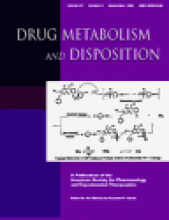Abstract
In a previous study in which a single 2.5 mg/kg (15.4 μmol/kg) s.c. dose of nicotine effected a transient, lung-specific induction of cytochrome P-450 (CYP) 1A1 in the rat, a dose-response study and assessment of the lung specificity of the induction was limited by toxicity of the acute parenteral nicotine exposure. In the present study, we examined the dose–CYP1A1/2 induction response relationship and the tissue specificity of the induction by orally administered nicotine, which lacks the toxicity of the parenterally administered drug. Nicotine, administered in a nutritionally balanced liquid diet, at a level of 20 (low), 60 (medium), or 200 (high) mg/kg of diet, induced CYP1A1 in the lung and kidney in a dose-dependent manner and in the liver at the high nicotine dose only, whereas CYP1A2 was induced in the liver dose-dependently and in the kidney at the high nicotine dose only. The high nicotine dose up-regulated mRNA level in the three tissues examined, but with the lung being the most responsive to the up-regulation. Induction of the CYP1A1-preferential activity ethoxyresorufin O-deethylase by the low, medium, and high nicotine diets was 1.9-, 4.9-, and 21.6-fold, respectively, in the lung, 1.4-, 1.7-, and 15.9-fold, respectively, in the kidney, and 1.7-, 2.9-, and 5.1-fold, respectively, in the liver. Similarly, albeit to lower extents, the dietary alkaloid induced the CYP1A2-preferential activity methoxyresorufin O-demethylase in all three tissues dose-dependently. Plasma nicotine concentration correlated neither with the dietary nor intake dose of the alkaloid nor with tissue levels of CYP1A, especially with the high-dose diet. Plasma nicotine levels at which CYP1A induction was maximal were comparable to those reported in smokers, suggesting that nicotine may induce CYP1A1 in humans.
Footnotes
-
Send reprint requests to: Michael M. Iba, Ph.D., Department of Pharmacology and Toxicology, EOHSI, 170 Frelinghuysen Rd., Piscataway, NJ 08854. E-mail: iba{at}eohsi.rutgers.edu
-
This work was supported by National Institute of Environmental Health Sciences Grant ES06414 (M.M.I.) and National Institute of Environmental Health Sciences Center Grant ES05022 support facilities.
- Abbreviations used are::
- PAH
- polyaromatic hydrocarbon
- CYP
- cytochrome P-450
- EROD
- ethoxyresorufinO-deethylase
- GAPDH
- glyceraldehyde-phosphate dehydrogenase
- MROD
- methoxyresorufin O-demethylase
- Received October 27, 1998.
- Accepted May 18, 1999.
- The American Society for Pharmacology and Experimental Therapeutics
DMD articles become freely available 12 months after publication, and remain freely available for 5 years.Non-open access articles that fall outside this five year window are available only to institutional subscribers and current ASPET members, or through the article purchase feature at the bottom of the page.
|






